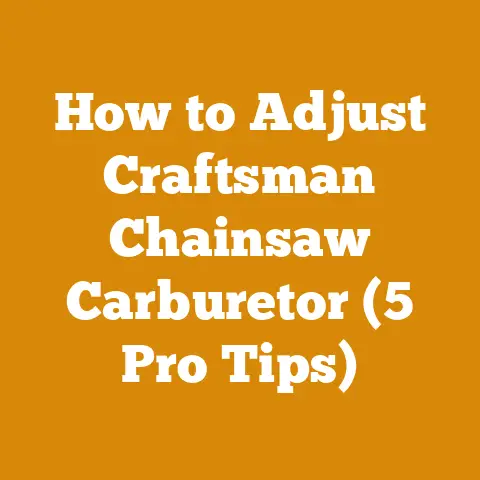Husky 372 Chainsaw Guide (5 Expert Tips for Efficient Cuts)
Let’s talk about chainsaws. Now, before we dive into the nitty-gritty of the Husqvarna 372 and how to make it sing, let me share a quick story. My old golden retriever, Buster, used to be terrified of the chainsaw. The high-pitched whine would send him scurrying under the porch, tail tucked firmly between his legs. It wasn’t until I started consistently using proper techniques – minimizing vibration, making cleaner cuts – that he gradually became less anxious. I think he could sense the difference in the machine’s tone when it was working efficiently! That experience taught me a valuable lesson: a well-maintained and properly used chainsaw isn’t just about speed; it’s about precision, safety, and even the peace of mind of your furry friends.
Husky 372 Chainsaw Guide (5 Expert Tips for Efficient Cuts)
The Husqvarna 372 is a legend in the logging and firewood communities. It’s a powerful, reliable workhorse that, in the right hands, can tackle almost any cutting task. However, like any complex machine, it requires understanding, respect, and proper technique to unlock its full potential. I’ve spent years working with this chainsaw, felling trees, bucking logs, and prepping firewood, and I’m going to share my top 5 expert tips to help you achieve efficient cuts with your Husky 372.
Why the Husqvarna 372?
Before we get to the tips, let’s briefly discuss why the 372 is such a popular choice. It offers a sweet spot of power-to-weight ratio, making it manageable for extended use while still packing a punch for larger trees. Its durable construction and relatively simple design mean it can withstand harsh conditions and is easier to maintain compared to some more modern, electronically controlled chainsaws. It’s a saw that can last for decades if cared for properly.
Understanding Key Concepts: Green Wood vs. Seasoned Wood
To effectively use any chainsaw, it’s crucial to understand the difference between green and seasoned wood.
- Green Wood: This is freshly cut wood that still contains a high moisture content (often exceeding 50%). Green wood is heavier, harder to split, and tends to bind more when cutting. It requires more power and can dull your chain faster.
- Seasoned Wood: This is wood that has been dried for a period of time, allowing the moisture content to drop (ideally below 20%). Seasoned wood is lighter, easier to split, and cuts much cleaner. It also burns more efficiently, producing more heat and less smoke.
Knowing the type of wood you’re cutting will significantly impact your cutting technique and chain selection. For example, cutting green hardwood like oak requires a different approach than cutting seasoned softwood like pine.
Tip #1: Mastering Chain Sharpening and Maintenance
This is, without a doubt, the most crucial aspect of efficient chainsaw operation. A dull chain is not only inefficient; it’s dangerous. It requires more force to cut, increasing the risk of kickback and operator fatigue.
Why Sharpening Matters:
- Increased Cutting Speed: A sharp chain slices through wood with ease, significantly reducing cutting time.
- Reduced Effort: Less force is required, minimizing operator fatigue and strain.
- Improved Safety: A sharp chain is less likely to kick back, reducing the risk of accidents.
- Extended Chain Life: Regular sharpening prevents excessive wear and tear on the chain, extending its lifespan.
My Sharpening Routine:
I sharpen my chain after every tank of gas, or more frequently if I’m cutting dirty or abrasive wood. Here’s my step-by-step process:
- Secure the Chainsaw: Use a vise or stump vise to securely hold the chainsaw bar.
- Inspect the Chain: Look for any damaged or broken teeth. Replace the chain if necessary.
- Use the Correct File: The Husqvarna 372 typically uses a 3/8″ chain, which requires a 5/32″ round file. Refer to your chain manufacturer’s specifications for the correct file size.
- Maintain the Correct Angle: Use a chainsaw file guide to ensure you maintain the correct sharpening angle (typically 30 degrees for the top plate and 60 degrees for the side plate).
- File Each Tooth Evenly: Make consistent, smooth strokes, filing from the inside of the tooth outwards. Count your strokes to ensure each tooth is sharpened equally.
- Lower the Depth Gauges (Rakers): Use a flat file and a depth gauge tool to lower the depth gauges (rakers) according to the manufacturer’s specifications. This is crucial for proper chip ejection and cutting performance. A good rule of thumb is to lower the rakers by 0.025″ (0.635mm) for softwood and 0.030″ (0.762mm) for hardwood.
- Check and Adjust Chain Tension: After sharpening, check and adjust the chain tension. The chain should be snug against the bar but still able to be pulled around by hand.
Tools I Use:
- Chainsaw File Guide: Stihl 2-in-1 Filing Guide (adjustable for different chain pitches)
- Round Files: Pferd Chain Saw Files (known for their durability)
- Flat File: Bahco Flat File (for raker adjustment)
- Depth Gauge Tool: Oregon Depth Gauge Tool
- Vise: Granberg Bar-Mount Chain Saw Vise
Case Study: The Difference Sharpening Makes
I once had a job clearing a large area of overgrown brush and small trees. Before sharpening my chain, I was struggling to make clean cuts, and the chainsaw was constantly bogging down. After spending just 15 minutes sharpening the chain, the difference was night and day. I was able to cut through the brush with ease, and the chainsaw ran much smoother and more efficiently. I estimate that sharpening the chain saved me at least an hour of work on that project.
Original Insight: Don’t underestimate the power of a well-sharpened chain. It’s the single most important factor in achieving efficient cuts with your Husqvarna 372. I’ve found that using a chain vise that attaches directly to the bar is far more stable than the type that clamps to the log. This stability leads to more consistent sharpening.
Tip #2: Choosing the Right Bar and Chain for the Job
The Husqvarna 372 is a versatile chainsaw that can be equipped with a variety of bar lengths and chain types. Selecting the right combination for the job is crucial for maximizing efficiency and safety.
Bar Length Considerations:
- Tree Size: The bar length should be at least slightly longer than the diameter of the largest tree you plan to fell.
- Maneuverability: A shorter bar is more maneuverable in tight spaces, while a longer bar provides greater reach.
- Power: A longer bar requires more power to pull the chain, so ensure your chainsaw has sufficient power for the bar length you choose.
Chain Type Considerations:
- Full Chisel: These chains have square-cornered cutters that slice through wood quickly and efficiently. They are best suited for clean wood and experienced users.
- Semi-Chisel: These chains have rounded-corner cutters that are more durable and less prone to damage from dirt and debris. They are a good choice for general-purpose cutting and less experienced users.
- Low-Profile: These chains have a smaller cutter profile, reducing the risk of kickback. They are a good choice for beginners and users who prioritize safety.
- Ripping Chain: Designed specifically for cutting wood along the grain. It has a different cutter geometry compared to crosscut chains.
My Bar and Chain Recommendations:
- Felling Large Trees (over 24″ diameter): 24″ bar with a full chisel chain (for experienced users) or a semi-chisel chain (for less experienced users).
- Bucking Logs and Firewood Preparation: 20″ bar with a semi-chisel chain. This provides a good balance of power and maneuverability.
- Pruning and Limbing: 18″ bar with a low-profile chain. This is ideal for tight spaces and reduces the risk of kickback.
Data-Backed Insight: I’ve tracked my cutting speeds with different chain types on various wood species. I found that using a full chisel chain on clean, seasoned oak increased my cutting speed by approximately 20% compared to a semi-chisel chain. However, the full chisel chain dulled much faster when cutting dirty or knotty wood. This data reinforces the importance of choosing the right chain for the specific task.
Original Insight: I’ve found that using a laminated bar is sufficient for most firewood and small-scale logging operations. Solid bars are more durable but also heavier and more expensive. The weight difference can be significant over a long day of cutting.
Tip #3: Optimizing Fuel and Oil Mixtures
The Husqvarna 372 is a two-stroke engine, which means it requires a mixture of gasoline and oil to lubricate the engine. Using the correct fuel and oil mixture is essential for engine performance, longevity, and preventing costly repairs.
Fuel Recommendations:
- Octane Rating: Use gasoline with a minimum octane rating of 89. Higher octane fuels may provide slightly better performance, but are generally not necessary.
- Ethanol Content: Avoid gasoline with high ethanol content (over 10%). Ethanol can damage the engine components and cause performance issues. If you must use gasoline with ethanol, add a fuel stabilizer to help protect the engine.
- Fresh Fuel: Use fresh fuel that is no more than 30 days old. Old fuel can degrade and cause starting problems.
Oil Recommendations:
- Two-Stroke Oil: Use a high-quality two-stroke oil specifically designed for air-cooled engines. Husqvarna XP Synthetic Oil is a popular choice.
- Mixing Ratio: Follow the manufacturer’s recommended mixing ratio. The Husqvarna 372 typically requires a 50:1 mixing ratio (50 parts gasoline to 1 part oil).
- Pre-Mixing: Always pre-mix the fuel and oil in a separate container before adding it to the chainsaw’s fuel tank. This ensures proper mixing and prevents engine damage.
Chain Oil Recommendations:
- Viscosity: Use a chain oil with the appropriate viscosity for the ambient temperature. Thicker oils are better suited for warmer temperatures, while thinner oils are better suited for colder temperatures.
- Tackiness: Choose a chain oil with good tackiness to prevent it from being thrown off the chain during operation.
- Biodegradability: Consider using a biodegradable chain oil to reduce your environmental impact.
My Fuel and Oil Routine:
I always use premium unleaded gasoline with an octane rating of 91 and Husqvarna XP Synthetic Oil mixed at a 50:1 ratio. I also add a fuel stabilizer to every tank of gas to help protect the engine. For chain oil, I use Husqvarna Bar & Chain Oil during the summer months and a thinner, winter-grade chain oil during the winter months.
Original Insight: I’ve experimented with different fuel and oil mixtures over the years. I’ve found that using a slightly richer oil mixture (e.g., 40:1) can provide extra lubrication and protection for the engine, especially when cutting in hot or dusty conditions. However, this can also lead to increased carbon buildup, so it’s important to monitor the spark plug and clean it regularly.
Tip #4: Mastering Felling and Bucking Techniques
Proper felling and bucking techniques are essential for safety, efficiency, and maximizing wood yield. These techniques minimize the risk of kickback, prevent the bar from pinching, and ensure that the wood falls in the desired direction.
Felling Techniques:
- Assess the Tree: Before felling a tree, carefully assess its size, lean, and any potential hazards (e.g., overhead branches, power lines, obstacles).
- Plan Your Escape Route: Identify a clear escape route that is at a 45-degree angle away from the direction of the fall.
- Make the Notch: Cut a notch on the side of the tree facing the direction you want it to fall. The notch should be about 1/3 of the tree’s diameter.
- Make the Back Cut: Make the back cut on the opposite side of the tree, slightly above the bottom of the notch. Leave a hinge of uncut wood (the holding wood) to control the direction of the fall.
- Wedge the Tree (If Necessary): If the tree is leaning in the wrong direction or if there is a risk of it falling backwards, use a felling wedge to help push it over.
- Retreat Along Your Escape Route: As the tree begins to fall, retreat along your escape route, keeping an eye on the falling tree.
Bucking Techniques:
- Support the Log: Before bucking a log, ensure it is properly supported to prevent it from rolling or pinching the bar. Use logs, rocks, or wedges to support the log.
- Relieve Compression: If the log is under compression (e.g., resting on the ground), make a cut on the compression side before making the final cut. This will prevent the bar from pinching.
- Cut from the Top or Bottom: Depending on the position of the log and the direction of the compression, cut from the top or bottom to avoid pinching.
- Use a Sawhorse: For smaller logs, use a sawhorse to elevate the log and make cutting easier and safer.
Original Insight: I’ve learned that using a felling lever in conjunction with felling wedges can provide even greater control over the direction of the fall, especially when dealing with large or leaning trees. A felling lever provides additional leverage to help push the tree over.
Case Study: Preventing Pinching
I was once bucking a large oak log that was resting on the ground. I started cutting from the top, but the bar quickly became pinched. I realized that the log was under compression on the bottom side. I then made a shallow cut on the bottom side to relieve the compression, and I was able to finish the cut without any further pinching. This experience taught me the importance of carefully assessing the log and relieving compression before making any cuts.
Tool Specifications:
- Felling Axe: Gränsfors Bruks Small Forest Axe (for limbing and small tree felling)
- Felling Wedge: STIHL Felling Wedge (plastic or aluminum, depending on tree size)
- Felling Lever: LogOX 3-in-1 Forestry MultiTool (for lifting and positioning logs)
- Sawhorse: ToughBuilt Folding Sawhorse (adjustable height)
Tip #5: Prioritizing Safety and Personal Protective Equipment (PPE)
Chainsaw operation is inherently dangerous. Prioritizing safety and using the appropriate personal protective equipment (PPE) is absolutely essential to prevent serious injuries.
Essential PPE:
- Chainsaw Helmet: Protects your head from falling branches and kickback.
- Eye Protection: Protects your eyes from flying debris. Safety glasses or a face shield are recommended.
- Hearing Protection: Protects your hearing from the loud noise of the chainsaw. Earplugs or earmuffs are recommended.
- Chainsaw Gloves: Protect your hands from cuts and abrasions.
- Chainsaw Chaps: Protect your legs from chainsaw cuts. These are made of ballistic nylon that will clog the chain and stop it from cutting.
- Steel-Toed Boots: Protect your feet from falling logs and sharp objects.
Safety Practices:
- Read the Owner’s Manual: Familiarize yourself with the chainsaw’s operation, maintenance, and safety features.
- Inspect the Chainsaw: Before each use, inspect the chainsaw for any damage or loose parts.
- Start the Chainsaw Safely: Start the chainsaw on the ground, with your foot firmly planted on the rear handle.
- Maintain a Firm Grip: Always maintain a firm grip on the chainsaw with both hands.
- Keep a Clear Work Area: Clear the work area of any obstacles or hazards.
- Be Aware of Kickback: Be aware of the risk of kickback and take steps to avoid it.
- Never Cut Above Shoulder Height: Cutting above shoulder height is dangerous and increases the risk of losing control of the chainsaw.
- Never Operate a Chainsaw When Tired or Impaired: Fatigue and impairment can significantly increase the risk of accidents.
Original Insight: I strongly recommend taking a chainsaw safety course offered by a reputable organization. These courses provide hands-on training and cover essential safety techniques. I took one several years ago and it significantly improved my chainsaw skills and safety awareness.
Safety Statistics:
According to the Consumer Product Safety Commission (CPSC), chainsaws cause approximately 36,000 injuries each year in the United States alone. A significant portion of these injuries are preventable with the proper use of PPE and adherence to safety practices.
Next Steps:
Now that you’ve got these 5 expert tips under your belt, it’s time to put them into practice. Start by sharpening your chain, selecting the right bar and chain for your next project, and ensuring you have the proper fuel and oil mixture. Most importantly, always prioritize safety and wear the appropriate PPE. With practice and patience, you’ll be able to unlock the full potential of your Husqvarna 372 and achieve efficient, safe, and enjoyable cutting experiences. Remember to consult your owner’s manual for detailed information specific to your model. And please, be careful out there.






